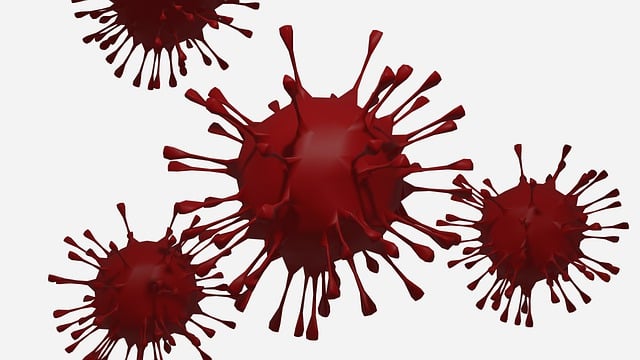High-resolution lung CT (HRCT) offers detailed cross-sectional images of lungs, resolving minute details as small as 0.5 mm. Radiologists analyze HRCT scans for inflammation, consolidations, and ground-glass opacities to detect pneumonia and pulmonary infections early and accurately. AI algorithms enhance HRCT's effectiveness, improving patient outcomes by enabling timely treatment decisions. This advanced imaging technique surpasses conventional X-rays in identifying pathologies indicative of lung infections.
Pneumonia and infections pose significant global health challenges, demanding accurate and early detection. This article explores cutting-edge imaging techniques, particularly High-Resolution Lung CT (HRCT), as powerful tools for identifying pneumonia’s subtle signs. We delve into the nuances of interpreting imaging results to ensure precise infection diagnosis. Additionally, we examine advanced HRCT applications and their pivotal role in clinical decision-making, highlighting the life-saving potential of these technologies.
High-Resolution Lung CT: Unveiling Pneumonia's Signs
High-resolution lung CT (HRCT) has emerged as a powerful tool in detecting pneumonia and other lung infections, offering detailed insights into the lungs’ intricate structures. Unlike conventional chest X-rays, HRCT provides highly detailed cross-sectional images of the lungs, allowing radiologists to identify subtle signs of inflammation and damage caused by pneumonia or other infectious conditions.
This advanced imaging technique utilizes specialized equipment to produce incredibly sharp pictures of the lungs, resolving minute details as small as 0.5 millimeters. Such high resolution enables the detection of tiny air spaces filled with fluid (known as consolidations), thin bands of inflammation, and subtle changes in lung architecture—all potential indicators of pneumonia or other infections. HRCT’s ability to visualize these intricate lung details makes it a valuable diagnostic tool, aiding in early and accurate identification of infectious processes.
Interpreting Imaging: Detecting Infections Accurately
Interpreting medical images, particularly high-resolution lung CT scans, is a critical step in accurately detecting pneumonia and other pulmonary infections. Radiologists closely examine these detailed images to identify signs of inflammation, consolidative lesions, and ground-glass opacities – all indicative of potential infections. Advanced computational techniques, such as artificial intelligence algorithms, are increasingly being integrated into this process to enhance accuracy and speed.
These AI tools can analyze large datasets of lung CT scans, learning patterns and features associated with various types of pneumonia and infections. By comparing new patient images against these trained models, healthcare providers gain a powerful tool for early and precise diagnosis. This not only facilitates timely treatment but also contributes to improved patient outcomes in the management of infectious diseases.
Advanced Techniques for Early Diagnosis
In the pursuit of early and accurate pneumonia detection, advanced imaging techniques have played a pivotal role. One of the most significant tools in modern diagnostics is high-resolution lung CT (Computed Tomography). This technology offers detailed, cross-sectional images of the lungs, allowing healthcare professionals to identify subtle signs of infection or inflammation that might be missed by conventional methods.
High-resolution lung CT provides a non-invasive way to visualize lung parenchyma, detect consolidation, and assess the extent of disease. By analyzing these images, doctors can make informed decisions about treatment plans, especially in cases where pneumonia is suspected but not readily apparent through physical examinations or standard imaging procedures. This early diagnosis capability is crucial in improving patient outcomes and ensuring prompt administration of appropriate therapies.
The Role of CT in Clinical Decision-Making
Computed Tomography (CT) scans play a pivotal role in clinical decision-making for detecting pneumonia and various infections. High-resolution lung CT, in particular, has become an indispensable tool for radiologists and healthcare professionals due to its ability to provide detailed, cross-sectional images of the lungs. These advanced images enable precise identification of consolidation, pleural effusions, and other pathologies indicative of pulmonary infections.
By offering superior spatial resolution compared to traditional X-rays, high-resolution lung CT allows for more accurate localization and characterization of lesions. This is particularly crucial in differentiating bacterial pneumonia from viral infections or other conditions with similar radiological appearances. Timely and correct diagnosis through high-resolution lung CT aids in appropriate treatment initiation, potentially improving patient outcomes and reducing the risk of complications associated with delayed treatment.
High-resolution lung CT plays a pivotal role in detecting pneumonia and infections, offering detailed insights into lung parenchyma. Accurate interpretation of imaging findings is key to timely diagnosis, guiding clinical decision-making, and ensuring appropriate treatment. Advanced techniques, such as machine learning algorithms, further enhance early detection capabilities. By leveraging these tools, healthcare professionals can navigate the complexities of lung diseases, ultimately improving patient outcomes and reducing morbidity and mortality associated with pneumonia.
